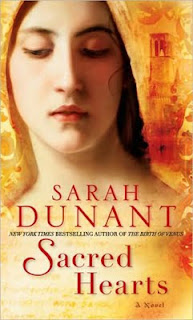I had eagerly anticipated "Sacred Hearts" after having read Sarah Dunant's other books, "The Birth of Venus" and "In the Company of the Courtesan". But "Sacred Hearts" was not what I had expected and I was disappointed with it at first.
I knew the book was about nuns, but I did not think that the entire book would take place in a convent. I thought that like the characters in the other two books, they would be involved in the world around them - 16th Renaissance Italy. For a time, I felt as trapped in the convent as newly-arrived novice Suora (Sister) Serafina.
In 1570, Italian convents were filled with the daughters of noblemen who were unable or unwilling to pay a dowry to marry them off, and Santa Caterina in Ferrara is no exception. Serafina's father finds the convent a perfect solution for a daughter who's been having a love affair with an unsuitable young man.
Like many girls before her at Santa Caterina, Serafina is a reluctant novice. But unlike most, she fiercely resists her fate, to the point of upsetting the entire convent with her rages. Although she has a beautiful singing voice, which would have been a tremendous asset to the convent, she refuses to sing for them.
Enter Suora Zuana, Santa Caterina's dispensary sister. A healer and herbalist, Suora Zuana is initially called upon to use her medicines to calm Serafina, but a bond soon develops between the older nun and the girl. In Serafina, Zuana sees a strong willed, spirited, intelligent girl who, like herself, shows a talent for medicine, and who, like herself, was sent to the convent against her will. (Zuana was placed there after her physician father died unexpectedly.) Zuana comes to care for the girl a great deal and tries to comfort her in her rage and sorrow.
Serafina's sense of being walled up alive inside the convent walls is very palpable and powerful. Just reading the book made me feel terribly claustrophobic.
I was soon caught up in the two women's struggles - Serafina's in trying to try to adapt and fit into her new life and Zuana's as she experiences continuing doubts about her faith.
I hugely enjoyed the characters of the two sisters as they take their journeys of devotion and doubt, obedience and disobedience, pain and joy. The "supporting" cast of characters is good as well. There is the abbess, Madonna Chiara, who in today's world would be an extremely competent company CEO. Suora Umiliana, the mistress of the novices, is engaged in a power struggle with the abbess and has enlisted a number of the sisters on her side. There is Suora Perseveranza, who goes to the extremes of faith by inflicting pain on herself. And then there is elderly Suora Magdalena, who has starved herself for many years (it is rumored that she only dines on the host) to the point where she has visions and raptures.
Mix them all together and you have a convent life that is not as boring as it would seem on the surface. And indeed, the outside world is pressing against the walls of the convent, as new church leaders try to impose more rules and regulations upon the already-burdened sisters.
The more the vibrant life of the sisters opened up to me, the less "trapped" I felt, and I ended up liking this book as well as Dunant's other, more adventurous, dramatic tales.

















